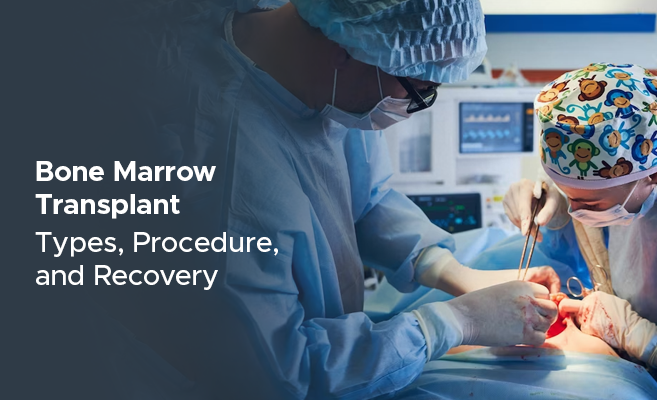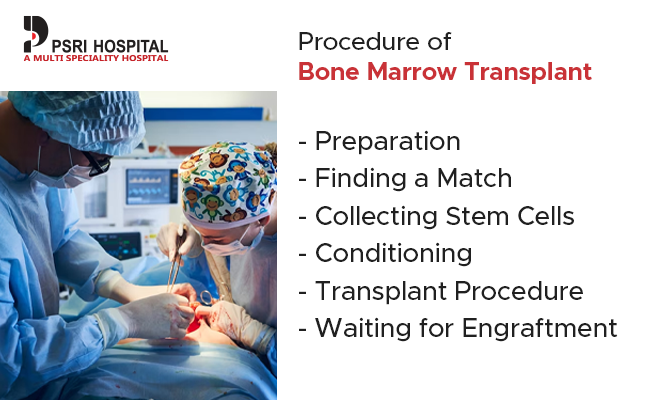Bone Marrow Transplant: Types, Procedure, and Recovery

Bone marrow is a vital tissue present in our body’s blood production system. It is responsible for generating blood cells that support our immune system, carry oxygen, and help in blood clotting. When this crucial system is compromised, either by disease or chemotherapy, a bone marrow transplant becomes a necessity. This procedure entails restoring a patient’s damaged bone marrow with healthy cells from a donor to revive the body’s blood and immune cell production. In this post, we will provide an overview of the bone marrow transplant process from preparation through recovery. Understanding the phases of treatment and aftercare can help you feel informed and empowered before undergoing a bone marrow transplant in Delhi. So, let’s start.
The Need for a Bone Marrow Transplant
A bone marrow transplant is recommended for patients with certain cancers, such as leukemia, lymphoma, and multiple myeloma, as well as for those with other blood disorders like aplastic anemia and sickle cell anemia. The procedure aims to replace the damaged or destroyed bone marrow with healthy marrow, essentially rebooting the body’s ability to produce blood cells.
Types of Bone Marrow Transplants
There are primarily two types of bone marrow transplants, distinguished by the source of the healthy cells:
Autologous Transplant: This involves using the patient’s own stem cells, collected before undergoing chemotherapy or radiation treatment. The cells are then returned to the patient’s body after these treatments.
Allogeneic Transplant: In this case, stem cells are donated by another person, a genetically compatible donor. This type can offer the added benefit of a donor immune response to fight certain types of cancer cells.

The Complete Procedure of Transplant
A bone marrow transplant process involves several critical steps, each designed to ensure the best possible outcome for the patient. Here is a detailed breakdown of the bone marrow transplant process:
Preparation: You will undergo extensive medical testing and exams to ensure you are strong enough for the procedure. You may be prescribed antibiotics, antifungals or antivirals as a preventative measure. Expect to have an IV line inserted to receive fluids and medications. Your medical team will continually monitor you and take blood samples.
Finding a Match: For allogeneic transplants, finding a compatible donor is crucial. This often involves testing family members or searching donor registries.
Collecting Stem Cells: In autologous transplants, the patient’s stem cells are collected and stored. For allogeneic transplants, the donor undergoes a similar process.
Conditioning: The patient then receives chemotherapy and/or radiation therapy. This step prepares the body for the new stem cells by clearing out the diseased marrow.
Transplant Procedure: On the day of bone marrow surgery, you will be given anesthesia and be asleep for the duration. Healthy stem cells from a donor are delivered into your bloodstream via an IV. The transplanted cells make their way to the cavities of large bones where they engraft and begin regenerating blood and immune cells. The procedure takes just a few hours and is typically done as an outpatient surgery. These cells then travel to the bone marrow and begin the regeneration process.
Waiting for Engraftment: This is when the new stem cells start to grow and produce healthy blood cells. It is a critical phase where the patient is closely monitored.
Recovery and Aftercare
Recovery from a bone marrow surgery is a time of careful monitoring and gradual healing:
Recovery in the Hospital
- Patients typically remain in the isolation unit for 4-6 weeks after the transplant.
- Medications will be given to help the donated cells engraft and prevent infections.
- Frequent lab tests are done to monitor blood counts and transplant success.
- IV nutrition or tube feeding may be used if you are unable to eat on your own initially.
- Once blood counts stabilize and side effects are managed, discharge from the hospital is planned.
At-Home Recovery and Lifestyle Adjustments
- Full recovery takes 6 to 12 months. During this period:
- Take all prescribed medications and attend frequent follow-up appointments.
- Avoid public settings and take precautions to prevent infection.
- Manage side effects like fatigue, muscle weakness, and appetite changes.
- Physical therapy and light exercise may help rebuild strength.
- Drink plenty of fluids and maintain a balanced nutritional diet.
With time, you will regain strength while your revitalized bone marrow brings your blood counts back to normal levels.
Understanding the Risks Involved in Bone Marrow Transplant
Both during and after the bone marrow transplant in India, patients face several risks that require careful management and vigilance:
Risks During the Transplant
Infection: The conditioning phase, involving chemotherapy or radiation, significantly weakens the immune system, making infections a primary concern. Hospitals take stringent precautions, and patients are given medications to help prevent infections.
Graft-versus-Host Disease (GVHD): In allogeneic transplants, the donor’s immune cells might attack the patient’s body, recognizing it as foreign. This can affect various organs and tissues, requiring prompt and effective treatment.
Rejection: There is a risk that the patient’s body might not accept the new stem cells, although this is less common due to meticulous matching processes and advancements in transplant techniques.
Conditioning Side Effects: The intensive chemotherapy or radiation used to prepare the body for the transplant can cause side effects ranging from nausea and fatigue to more severe complications affecting organs like the heart, liver, or lungs.
Risks After the Transplant
The journey doesn’t end with the transplant procedure; the recovery phase comes with its own set of risks and challenges:
Prolonged Immune System Weakness: Even after engraftment, the immune system takes time to fully recover, extending the period during which patients are vulnerable to infections.
Late-Onset GVHD: GVHD can occur months or even years after the transplant, necessitating ongoing monitoring and, sometimes, long-term immunosuppressive therapy.
Secondary Cancers: The treatments involved in a bone marrow transplant, particularly radiation, can increase the risk of developing another cancer in the future.
Emotional and Mental Health Challenges: The physical and emotional challenge of undergoing a bone marrow transplant can affect mental health. Support from mental health professionals, along with family and community support, plays a crucial role in recovery.
Conclusion
A bone marrow transplant in India represents not just a treatment but a chance for many patients to start anew. The journey from diagnosis through recovery is filled with challenges, but with the right care and support, it can also be a journey of hope and renewal. PSRI Hospital is a best hospital for bone marrow transplant in India which is dedicated to making this journey as smooth and successful as possible, providing the best bone marrow transplant treatments and care.
FAQs
How do I know if I need a bone marrow transplant?
Ans. If you are dealing with certain types of cancers like leukemia or lymphoma, or blood disorders like aplastic anemia, a bone marrow transplant might be recommended. Your doctors will run tests and consider your overall health and the specifics of your condition before suggesting a transplant as the best course of action.
How long does it take to recover from a bone marrow transplant?
Ans. Recovery varies from person to person, depending on the type of transplant, your overall health, and how well you respond to the procedure. Generally, it can take several months to a year to fully recover, with the first few months being the most critical for monitoring and managing any complications.
What are the chances of success with a bone marrow transplant?
Ans. The success rate of bone marrow transplants has improved significantly over the years, thanks to advances in medical research and treatment methods. However, success can depend on various factors, including the reason for the transplant, the match between donor and recipient, and the patient’s health.
Can I lead a normal life after a bone marrow transplant?
Ans. Many patients go on to lead active, fulfilling lives after their recovery. While you may need to take some precautions, especially in the first year after the transplant, and attend regular follow-up appointments, most patients can return to their daily routines.

 Book An Appointment
Book An Appointment Virtual Consultation
Virtual Consultation




